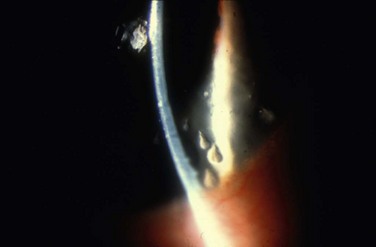28 Filamentary keratitis is a condition in which mucoid filaments are attached to the anterior corneal surface and cause a foreign body sensation in the patient (Fig. 28.1). Filamentary keratitis is associated with dry eyes, superficial punctate keratopathy, ptosis, and tear film stasis. Patients affected with filamentary keratitis are often highly symptomatic; the filaments may cause a persistent foreign body sensation, photophobia, and redness, that can range from moderate to severe in intensity. Filamentary keratitis is associated with a wide range of conditions in which the ocular surface is abnormal. Treatment can be acute or chronic, and severe cases may require multiple therapeutic modalities. The filaments adherent to the corneal epithelium in filamentary keratitis are gelatinous and refractile in appearance and can vary from 0.5 mm sessile adhesions, to 10 mm strings;1 filaments are generally attached to the basement membrane of the corneal epithelium at one end, with the other end freely moveable. Movement of the lids causes the filament to elongate and coil, which is thought to produce patient discomfort. Filamentary keratitis is associated with underlying basement membrane abnormalities, most of which are related to hypertonic tear film states. A list of conditions that are associated with filamentary keratitis can be seen in Box 28.1.2–18 A relative deficiency in the aqueous component of the tear film is usually present in filamentary keratitis, which produces a relative increase in the mucinous component. The ratio of mucus to aqueous is usually increased because of a decrease in aqueous tear production, but can also occur from mucus production19 or abnormal mucus accumulation. Abnormalities of the ocular surface result in defects in the corneal epithelium that allow for anchoring of filaments. Ptosis may lead to a reduction in oxygenation of the corneal epithelium, as well as poor tear distribution underneath the lid, which can predispose to or exacerbate filament formation.2 Reactive ptosis from discomfort only serves to worsen the problem. The disorder most frequently associated with filamentary keratitis is dry eye disease. The increase in the mucus-to-aqueous ratio in the tear film may be brought about by either reduced aqueous tear secretion or increased tear film stasis, both of which effectively increase tear film osmolarity. Mucus serves as a disposal system for exfoliated epithelial cells.20 For example, changes in the composition of the mucinous layer, in which mucus becomes more viscous, enhance the adherence of mucus to irregularities in the corneal epithelium. One example of this change occurs when the normally predominant sialomucin is replaced by more viscous sulfomucin in certain disease states.19 Adherence of mucus to the epithelium is more likely with the latter. The combination of epithelial damage, such as that seen in dry eyes or stasis conditions, combined with an increase in mucus viscosity, can increase the potential for filaments to form on the cornea. Aqueous tear insufficiency decreases lubrication and increases the viscosity of the mucin layer, thereby leading to increased sloughing of epithelial cells, epithelial defects, and viscous mucus – the basic constituents of the corneal filament.
Filamentary Keratitis
Introduction
Etiology
Ento Key
Fastest Otolaryngology & Ophthalmology Insight Engine




